
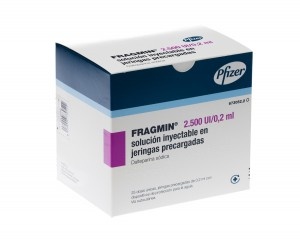
ФРАГМИН 2500 МЕ/мл раствор для инъекций в ампулах

Спросите врача о рецепте на ФРАГМИН 2500 МЕ/мл раствор для инъекций в ампулах

Инструкция по применению ФРАГМИН 2500 МЕ/мл раствор для инъекций в ампулах
Введение
Прошпект: Информация для пользователя
ФРАГМИН2.500 МЕ/млраствор для инъекций в ампулах
дальтепарин натрия
Прочитайте внимательно весь прошпект перед началом использования лекарства, поскольку он содержит важную информацию для вас.
- Сохраните этот прошпект, поскольку вам может потребоваться прочитать его снова.
- Если у вас есть какие-либо вопросы, проконсультируйтесь с вашим врачом, фармацевтом или медицинским работником.
- Это лекарство было назначено только вам и не должно быть передано другим людям, даже если у них есть相同ные симптомы, поскольку оно может нанести им вред.
- Если вы испытываете побочные эффекты, проконсультируйтесь с вашим врачом, фармацевтом или медицинским работником, даже если это побочные эффекты, которые не указаны в этом прошпекте. См. раздел 4.
Содержание прошпекта:
- Что такое Фрагмин и для чего он используется
- Что вам нужно знать перед началом использования Фрагмина
- Как использовать Фрагмин
- Возможные побочные эффекты
- Хранение Фрагмина
- Содержание упаковки и дополнительная информация
1. Что такое Фрагмин и для чего он используется
Фрагмин относится к группе лекарств, называемых низкомолекулярными гепаринами.
Фрагмин 2.500 МЕ/мл используется у детей и подростков в возрасте от 1 месяца для лечения тромбов в венах (тромбоэмболия или ТЭ).
2. Что вам нужно знать перед началом использования Фрагмина
Не используйте Фрагмин, если:
- вы аллергичны (гиперчувствительны) к дальтепарину натрия или любому другому компоненту этого лекарства (указанному в разделе 6), или к любому типу гепарина (лекарств, предотвращающих свертывание крови) отличному от дальтепарина натрия или продуктов, полученных из свинины,
- вы страдаете острым гастродуоденальным язвой, церебральным кровотечением или другим значительным кровотечением,
- у вас есть тяжелые нарушения свертывания,
- у вас есть заболевание, называемое острым септическим или подострым эндокардитом (воспаление одной из оболочек сердца, вызванное инфекцией),
- вы перенесли операцию на центральной нервной системе, глазах или ушах, или если у вас есть травмы этих органов или системы,
- у вас есть снижение количества тромбоцитов (клеток, присутствующих в крови, участвующих в свертывании крови) и когда проводится тест на агрегацию в присутствии дальтепарина натрия, результат положительный.
Если вы проходите лечение Фрагмином, вам не могут быть назначены эпидуральная или спинальная анестезия.
Предостережения и меры предосторожности:
Проконсультируйтесь с вашим врачом, фармацевтом или медицинским работником перед началом использования Фрагмина, если:
- Вы будете получать внутримышечные инъекции других лекарств из-за риска гематом.
- У вас есть снижение количества тромбоцитов или дефекты в них. Ваш врач может назначить вам специальные тесты для определения причины этой проблемы.
- У вас есть тяжелая почечная недостаточность (снижение функции почек) или тяжелая печеночная недостаточность (снижение функции печени).
- У вас есть высокое артериальное давление и оно не контролируется.
- У вас есть заболевания сетчатки (части глаза) из-за диабета или высокого артериального давления.
- Вы недавно перенесли операцию или имеете высокий риск кровотечения.
- У вас был острый инфаркт миокарда и вы проходите лечение этим лекарством.
- У вас есть риск повышения уровня калия в крови из-за какой-либо болезни или приема определенных лекарств. Ваш врач может назначить вам анализ для измерения уровня калия.
- Вы проходите эпидуральную анестезию (в одной из оболочек, окружающих мозг и спинной мозг) или спинальную анестезию (в спинном мозге) или люмбальную пункцию, и вам вводится гепарин в профилактических целях, могут появиться очень редко гематомы в этих областях. Если вы чувствуете боль в пояснице, онемение, слабость в нижних конечностях или какой-либо нарушение функции кишечника или мочевого пузыря, немедленно сообщите вашему врачу.
- У вас есть искусственный клапан сердца, профилактические дозы Фрагмина могут быть недостаточными для предотвращения клапанной тромбозы.
- Вы получаете длительное лечение нестабильной коронарной болезни, как перед реваскуляризацией, ваш врач может снизить вам дозу Фрагмина.
Учитывая ваше состояние и/или возраст, ваш врач может провести тесты для контроля антикоагулянтной активности и предотвращения риска кровотечения или повторения тромбоза.
Фрагмин не должен быть заменен другими нефракционированными гепаринами, низкомолекулярными гепаринами или синтетическими полисахаридами, поскольку их эффект может быть не таким же.
Дети и подростки:
Фрагмин не используется для детей младше 1 месяца.
Другие лекарства и Фрагмин:
Сообщите вашему врачу или фармацевту, если вы используете, недавно использовали или можете использовать любое другое лекарство, включая те, которые можно купить без рецепта.
Некоторые лекарства могут взаимодействовать с Фрагмином; в этих случаях может быть необходимо изменить дозу или прекратить лечение одним из лекарств.
Тромболитическая терапия (которая растворяет тромб) или некоторые лекарства, влияющие на свертывание крови, могут увеличить риск кровотечения при сочетании с Фрагмином:
- Аспирин (ацетилсалициловая кислота).
- Ингибиторы тромбоцитов (которые используются для уменьшения агрегации тромбоцитов и снижения риска тромбов).
- Тромболитики (которые используются для растворения тромбов).
- Нестероидные противовоспалительные препараты (НПВП) (лекарства, используемые для лечения воспаления).
- Антагонисты витамина К и другие типы антикоагулянтов.
- Декстран (используется в некоторых искусственных слезах).
Беременность, лактация и фертильность
Если вы беременны или в период лактации, считаете, что можете быть беременной или планируете стать беременной, проконсультируйтесь с вашим врачом или фармацевтом перед использованием этого лекарства.
Проконсультируйтесь с вашим врачом или фармацевтом перед приемом или использованием любого лекарства, включая Фрагмин.
Если вы беременны, используйте это лекарство только тогда, когда это явно необходимо, хотя Фрагмин не проникает через плаценту.
Не рекомендуется использовать его вместе с эпидуральной анестезией. Сообщите вашему врачу, если у вас есть искусственный клапан сердца.
Если вы кормите грудью, сообщите вашему врачу; он оценит, подходит ли лечение этим лекарством, поскольку Фрагмин проникает в небольшом количестве в грудное молоко.
Вождение и использование машин:
Это лекарство не влияет на способность управлять транспортными средствами или использовать машины.
Фрагмин содержит натрий:
Это лекарство содержит 44,1 мг натрия (основного компонента столовой соли) в каждой ампуле. Это эквивалентно 2,21% максимальной суточной нормы потребления натрия, рекомендуемой для взрослых.
.
3. Как использовать Фрагмин
Следуйте точно инструкциям по введению этого лекарства, указанным вашим врачом. Проконсультируйтесь с вашим врачом, фармацевтом или медицинским работником, если у вас есть вопросы.
Помните использовать ваше лекарство.
Ваш врач укажет вам дозу, способ применения и продолжительность лечения Фрагмином.
Использование у детей и подростков:
Лечение тромбов в венах (тромбоэмболия [ТЭ] с симптомами)
Рекомендуемые дозы зависят от веса ребенка и возрастной группы. Врач рассчитает дозу. Врач посоветует вам индивидуальную дозу Фрагмина в соответствии с этими критериями. Не изменяйте дозу или схему лечения без предварительной консультации с вашим врачом.
Следующая таблица показывает рекомендуемую начальную дозу для детей и подростков в зависимости от их возраста:
Дети от 1месяца до 2лет:150 МЕ/кг дважды в день.
Дети от 2лет до 8лет:125 МЕ/кг дважды в день.
Дети от 8лет до 18лет:100 МЕ/кг дважды в день.
Эффект Фрагмина будет контролироваться после начальной дозы и последующего корректировки дозы с помощью анализа крови.
Как вводить Фрагмин
Ваше лекарство будет вводиться обычно врачом или медсестрой. Фрагмин вводится под кожу (подкожно).
У детей Фрагмин обычно вводится в складку кожи на животе (область в форме "U" вокруг пупка) или на передней части бедер.
Иногда вам может потребоваться вводить Фрагмин вне больницы. Если необходимо разбавить Фрагмин перед введением детям, это должно сделать медицинский работник. Следуйте инструкциям вашего врача о том, как и когда вводить разбавленное лекарство (см. раздел "Следуйте шагам, описанным ниже").
Этот раздел прошпекта объясняет, как вводить Фрагмин самостоятельно или вашему ребенку. Следуйте этим инструкциям только после того, как были обучены вашим врачом. Если вы не уверены, что делать, немедленно проконсультируйтесь с вашим врачом. Вводите (или вводите) дозу Фрагмина в назначенное время, указанное вашим врачом.
Следуйте шагам, описанным ниже
Шаг 1: подготовка шприца для инъекции:
Соберите все необходимые материалы: ампулу, шприц, ватный тампон с алкоголем или водой и мылом. Ампула, шприц и игла имеют защитные колпачки. Колпачок ампулы может поворачиваться; это нормально. Проверьте, что все колпачки правильно установлены, и если они не установлены правильно, не используйте их. Если игла согнута, не используйте ее.
Прежде чем начать, убедитесь, что знаете, сколько нужно вводить. Ваш врач должен был указать вам количество раствора, которое необходимо вводить. Если врач не дал вам это указание, свяжитесь с ним.
Подготовьте дозу лекарства:снимите пластиковую крышку с верхней части ампулы (если она присутствует). Не снимайте резиновую пробку или алюминиевое кольцо, находящееся на верхней части ампулы. Очистите резиновую пробку ампулы ватным тампоном с алкоголем. После очистки не трогайте пробку руками и не допускайте, чтобы она соприкасалась с любой поверхностью (см. рисунки 1 и 2).
Рисунок 1 Рисунок 2
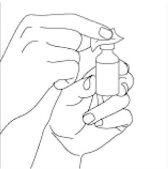
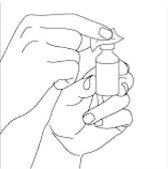
Взять правильную дозу из ампулы:выньте шприц из пластиковой или бумажной упаковки. Снимите колпачок, покрывающий иглу. Будьте осторожны, чтобы не трогать иглу. С ампулой в вертикальном положении, вставьте иглу под углом 90 градусов в пробку ампулы. Будьте осторожны, чтобы не согнуть иглу (см. рисунок 3).
Рисунок 3
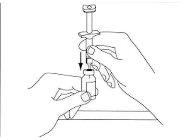
Положите ампулу вниз, держа иглу, соединенную с шприцем, в ампуле. Игла и шприц будут указывать вверх (см. рисунок 4).
Рисунок 4
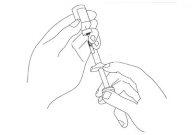
Убедитесь, что кончик иглы полностью покрыт лекарством. Потяните за поршень шприца до правильной дозы лекарства, проверяя отметки уровня дозы на боку цилиндра шприца (см. рисунок 5).
Рисунок 5
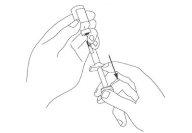
Держите ампулу вниз, с иглой в ампуле, указывающей вверх. Аккуратно постучите по шприцу или "переместите" его кончиками пальцев. Это помогает переместить пузырьки в верхнюю часть шприца (см. рисунок 6).
Рисунок 6

Как только пузырьки окажутся в верхней части шприца, аккуратно нажмите на поршень, чтобы заставить пузырьки выйти из шприца и вернуться в ампулу. Медленно потяните за поршень шприца снова до правильной дозы, избегая пузырьков.
После удаления пузырьков проверьте количество лекарства в шприце в соответствии с отметками дозы на боку цилиндра шприца, чтобы убедиться, что оно правильное.
Теперь вы готовы к инъекции. Продолжайте с шагом 2.
Шаг 2: выбор и подготовка места подкожной инъекции
Если вы вводите себе или взрослому, вы можете вводить Фрагмин в область на правой или левой стороне живота или на любой из двух сторон (см. затененные области на рисунке 7).
Рисунок 7
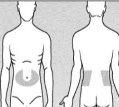
Если вы вводите Фрагмин ребенку, выберите одно из рекомендуемых мест инъекции (см. затененные области на рисунке 8):
Область в форме "U" вокруг пупка.
Передняя часть бедер.
Рисунок 8

- Используйте разное место инъекции каждый раз, когда вводите дозу.
- Не вводите инъекцию в области, где кожа болезненна, синяя, красная или твердая. Избегайте областей с шрамами.
- Если вы или ребенок страдаете псориазом, не вводите инъекцию直接 в любую приподнятую, толстую, красную или чешуйчатую кожную поражение ("кожные поражения псориаза").
- Вымойте и высушите руки.
- Очистите место инъекции новым ватным тампоном с алкоголем, используя круговые движения. Дайте коже полностью высохнуть. Не трогайте эту область снова перед введением инъекции.
Шаг 3: принятие правильного положения
Вы или ваш ребенок должны быть в сидячем или лежачем положении для введения подкожной инъекции. Если вы будете вводить себе лекарство, сядьте в удобное положение, в котором вы можете видеть свой живот (см. рисунок 9).
Рисунок 9
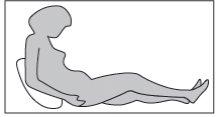
Шаг 4:
Большими и указательными пальцами поднимите складку кожи одной рукой. Другой рукой держите шприц, как если бы он был карандашом. Это будет место инъекции.
Шаг 5:
Если вы вводите Фрагмин взрослому или себе,держите шприц над складкой кожи, держа его под прямым углом (т.е. вертикально, как на схеме, и не под углом). Введите иглу в кожу до тех пор, пока она не будет полностью внутри (см. рисунок 10).
Рисунок 10
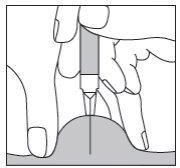
Если вы вводите Фрагмин ребенку,введите иглу в кожу до конца с небольшим и быстрым движением, под углом 45° до 90° (см. рисунок 11).
Рисунок 11
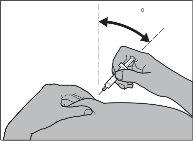
Шаг 6:
Шаг 6:
Полностью нажмите на поршень, чтобы ввести правильную дозу, с постоянной и медленной скоростью. Продолжайте держать складку кожи, пока вводите инъекцию, и затем отпустите складку кожи и выньте иглу.
Если есть какое-либо кровотечение в месте инъекции, примените легкое давление. Не трите место инъекции, поскольку это может вызвать гематомы.
Нажмите на место инъекции ватным тампоном в течение 10 секунд. Может произойти легкое кровотечение. Не трите место инъекции. Вы можете положить повязку на место инъекции.
Шаг 7:
Утилизируйте шприц и иглу в контейнер для острых предметов. Держите контейнер для острых предметов вне досягаемости других людей. Когда контейнер для острых предметов почти заполнен, утилизируйте его в соответствии с инструкциями или проконсультируйтесь с вашим врачом или медсестрой.
Если вы использовали больше Фрагмина, чем должно быть
Если вы использовали больше Фрагмина, чем должно быть, немедленно проконсультируйтесь с вашим врачом или фармацевтом, обратитесь в ближайшую больницу или проконсультируйтесь с центром токсикологической информации, телефон 91 562 04 20.
Если вы забыли использовать Фрагмин
Немедленно проконсультируйтесь с вашим врачом или фармацевтом.
Не вводите двойную дозу, чтобы компенсировать пропущенные дозы.
Если у вас есть какие-либо другие вопросы о использовании этого лекарства, проконсультируйтесь с вашим врачом, фармацевтом или медсестрой.
4. Возможные побочные эффекты
Как и все лекарства, Фрагмин может вызывать побочные эффекты, хотя не все люди их испытывают.
Часто встречающиеся побочные эффекты (могут повлиять на до одного из десяти пациентов):
- Боль и появление синяков в месте инъекции
- Временное обратимое уменьшение количества тромбоцитов в крови, не обусловленное иммунными механизмами (тип 1)
- Кровотечение в любом месте, иногда приводящее к смертельному исходу
- Временное увеличение активности ферментов печени
Редкие побочные эффекты (могут повлиять на до одного из тысячи пациентов):
- Потеря волос, некроз клеток кожи
Побочные эффекты с неизвестной частотой (не могут быть оценены на основе доступных данных):
- Уменьшение количества тромбоцитов в крови, обусловленное иммунными механизмами, индуцированными гепарином (тип 2)
- Тяжелые аллергические реакции
- Местное кровотечение внутри черепа, внутри брюшной полости или в других местах, иногда приводящее к смертельному исходу
- Сыпь
- Накопление крови внутри черепа или позвоночника (эпидуральный или спинной гематома)
- Повышение уровня калия в крови
- Остеопороз (пористость костей)
Ожидается, что побочные эффекты у детей будут такими же, как и у взрослых. Однако имеется мало информации о возможных побочных эффектах при длительном использовании у детей.
Сообщение о побочных эффектах:
Если вы испытываете любой побочный эффект, проконсультируйтесь с вашим врачом или фармацевтом, даже если это возможные побочные эффекты, не указанные в этом листке-вкладыше. Вы также можете сообщить о них напрямую через Испанскую систему фармакологического надзора за лекарствами для человека: www.notificaram.es. Сообщая о побочных эффектах, вы можете способствовать предоставлению более полной информации о безопасности этого лекарства.
5. Хранение Фрагмина
Хранить в недоступном для детей месте.
Не хранить при температуре выше 25°C
Не использовать Фрагмин после даты истечения срока годности (CAD), указанной на упаковке и картоне. Дата истечения срока годности - последний день месяца, указанного в ней.
Не использовать Фрагмин, если вы заметили видимые признаки порчи.
С микробиологической точки зрения, продукт должен быть использован немедленно. Если он не используется немедленно, сроки и условия хранения во время использования являются ответственностью пользователя.
Лекарства не должны быть выброшены в канализацию или в мусор. Положите упаковку и лекарства, которые вам больше не нужны, в специальный пункт сбора в аптеке. Если у вас есть сомнения, спросите у вашего фармацевта, как избавиться от упаковки и лекарств, которые вам больше не нужны. Таким образом, вы поможете защитить окружающую среду.
6. Содержание упаковки и дополнительная информация
Состав Фрагмина 2 500 МЕ/мл:
Активным веществом Фрагмина 2 500 МЕ/мл является далтепарин натрия.
Каждый миллилитр раствора содержит 2 500 МЕ (анти-Xa) далтепарина натрия. Общее содержание в упаковке 4 мл составляет 10 000 МЕ (анти-Xa) (= 10 000 МЕ/4 мл).
Другими компонентами являются: хлорид натрия, гидроксид натрия, соляная кислота и вода для инъекций.
Внешний видФрагмина 2 500 МЕ/мли содержание упаковки:
Ампулы по 4 мл: инъекционный раствор для подкожного введения в ампулах с 10 000 МЕ (анти-Xa)/4 мл (2 500 МЕ/мл).
Владелец разрешения на маркетинг:
Pfizer, S.L.
Avda. de Europa 20-B.
Parque Empresarial La Moraleja
28108 Alcobendas (Мадрид)
Производитель:
Pfizer Manufacturing Belgium NV
Rijksweg 12
2870 Puurs-Sint-Amands
Бельгия
Дополнительная информация для медицинского персонала:
Фрагмин 2 500 МЕ/мл можно разбавить растворами для инфузии хлорида натрия (9 мг/мл) или глюкозы (50 мг/мл) в стеклянных и пластиковых контейнерах.
.
Совместимость этого лекарства с другими продуктами, кроме вышеуказанных, не изучалась.
Дата последнего пересмотра этого листка-вкладыша: июнь 2025
Подробная и актуальная информация о этом лекарстве доступна на сайте Испанского агентства по лекарствам и медицинским изделиям (AEMPS) http://www.aemps.gob.es

Сколько стоит ФРАГМИН 2500 МЕ/мл раствор для инъекций в ампулах в Испании в 2025 году?
Средняя цена на ФРАГМИН 2500 МЕ/мл раствор для инъекций в ампулах в декабрь, 2025 года составляет около 71.65 евро. Финальная стоимость может зависеть от региона, конкретной аптеки и рецептурного статуса. Для точной информации лучше проверить онлайн или в ближайшей аптеке.
- Страна регистрации
- Средняя цена в аптеках71.65 EUR
- Активное вещество
- Требуется рецептДа
- Производитель
- Информация носит справочный характер и не является медицинской рекомендацией. Перед приемом любых препаратов проконсультируйтесь с врачом. Oladoctor не несет ответственности за медицинские решения, принятые на основе этого контента.
- Аналоги ФРАГМИН 2500 МЕ/мл раствор для инъекций в ампулахФорма выпуска: ИНЪЕКЦИОННЫЙ РАСТВОР, 10 000 МЕ дальтепарина натрия/0,4 млАктивное вещество: dalteparinПроизводитель: Pfizer S.L.Требуется рецептФорма выпуска: ИНЪЕКЦИОННЫЙ РАСТВОР, 10 000 МЕ/млАктивное вещество: dalteparinПроизводитель: Pfizer S.L.Требуется рецептФорма выпуска: ИНЪЕКЦИОННЫЙ РАСТВОР, 12 500 МЕ далтепарина натрия/0,5 млАктивное вещество: dalteparinПроизводитель: Pfizer S.L.Требуется рецепт
Аналоги ФРАГМИН 2500 МЕ/мл раствор для инъекций в ампулах в других странах
Лучшие аналоги с тем же действующим веществом и терапевтическим эффектом.
Аналог ФРАГМИН 2500 МЕ/мл раствор для инъекций в ампулах в Польща
Врачи онлайн по ФРАГМИН 2500 МЕ/мл раствор для инъекций в ампулах
Консультация по дозировке, побочным эффектам, взаимодействиям, противопоказаниям и продлению рецепта на ФРАГМИН 2500 МЕ/мл раствор для инъекций в ампулах – по решению врача и с учетом местных правил.














